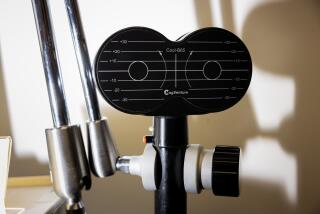State Study Finds Sharp Rise in Autism Rate
- Share via
The number of autistic children in California has exploded during the last decade, according to a new state survey released Thursday.
The survey, conducted by the state Department of Developmental Services, concludes that there were 11,995 autistic children enrolled in the department’s 21 regional programs in 1998, a 210% increase compared with the 3,864 enrolled in 1987.
During the same period, enrollment of children with other disorders, such as cerebral palsy and epilepsy, has increased at a rate consistent with the state’s population growth--about 30% to 40%.
“Autism is increasing at an alarming rate,” said psychologist Ron Huff, who wrote the study. “That raises a lot of questions” that have few answers yet, he said.
“We’re in the middle of an autism epidemic,” says Dr. Bernard Rimland of the Autism Research Institute in San Diego.
The chief question is how much of the increase reflects actual growth in the disorder as opposed to more common diagnosis and greater awareness. Researchers believe both may be playing a part.
“I was never taught anything about it” in medical school, said Dr. Pauline Filipek of UC Irvine. “I heard the ‘A word’ twice in seven years of postgraduate education, and never in medical school.”
But even with increased awareness, “A lot of us feel that there is an increase in the actual prevalence,” she added, “but we don’t really have the data to show that.”
One answer that researchers do have is that California is probably not unique. “There is absolutely no doubt the numbers are going up nationwide, even worldwide,” said Dr. Eric London of the National Alliance for Autism Research. Between 1975 and 1985 studies showed the worldwide rate of autism to be about 4 cases per 10,000. Between 1985 and 1995, the numbers tripled to 12 per 10,000. But researchers believe that the actual rate may be much higher, on the order of one in 500 children.
Autism is a severe developmental disorder in which children seem isolated from the world around them. There are a broad spectrum of symptoms, but it is marked by poor language skills and an inability to handle social relations. No cure exists, but many problems can be alleviated with intensive behavioral therapy. Some parents have reported marked improvement in children treated with certain drugs, including secretin or Prozac, but clinical trials have not yet confirmed those claims.
The new report’s numbers may actually understate the number of autistic children in the state, Filipek said. Some autistic children are incorrectly given other diagnoses, such as attention deficit hyperactivity disorder.
Particular attention has been paid to reported clusters of autism cases. Last year, for example, parents in Brick Township, N.J., became alarmed when they observed an unusual number of autism cases in their blue-collar community of 71,000. Among an estimated 6,000 children between the ages of three and ten, parents identified 53 cases of autism--an incidence of just over four cases for every 500 children.
Many parents attribute the cases to a nearby landfill, but epidemiologists from the federal Centers for Disease Control and Prevention have been unable so far to identify any unusual pollutants in the air or water of the area.
But Rimland, for one, says he is not sure the number of autism cases in Brick Township are actually elevated above the norm. “I think this is just a cross-section of what would be found if you looked carefully anywhere in America,” he said.
Rick Rollins, a former secretary of the California state Assembly who was instrumental in creating the new autism research center at UC Davis points to his own community of Granite Bay, a wealthy suburb of Sacramento.
Of the 2,930 children enrolled in grades K-6 in the Eureka Union School District that serves Granite Bay, he said, 22 are autistic, a rate comparable to that found in Brick Township. There is no industry in Granite Bay and the area is “environmentaly pristine,” and “geographically as different from Brick as you can get,” Rollins said.
Beyond increased awareness, experts have proposed many possible causes for the apparent increase in autism. Some have speculated the syndrome is induced by infectious agents or by an allergic reaction to foods, such as proteins in milk. Others blame an allergic reaction to vaccines. Indeed, several parents of autistic children in Great Britain are suing the maker of the mumps-measles-rubella vaccine, claiming it triggered the disease.
But Kathleen Stratton, a vaccine specialist at the Institute of Medicine, a quasi-governmental think tank in Washington, D.C., believes that connection to be unlikely. “Childhood vaccine safety is very contentious, very emotional,” she said, but any link between the vaccine and autism “has not been proved by any means.”
Government officials are pushing for more research funds for the disease. “What is generally considered a rare condition is increasing faster here than other developmental disabilities,” said state Sen. John Burton, the Senate majority leader. “We need to find out why.”
The Department of Developmental Services provides a variety of services to parents of children with developmental delays, including respite care, training in behavioral interventions, and help in locationg dentists and other professionals.
(BEGIN TEXT OF INFOBOX / INFOGRAPHIC)
Developmental Disorders Increase
The number of autistic children and adolescents enrolled in programs run by the state Department of Developmental Services has grown sharply over the past decade, while the number with other developmental disorders has increased in tandem with increases in the population, according to a new state report.
*--*
Disorder 1987 188 % Change Autism 3,864 11,995 210% Cerebral Palsy 19,972 28,529 43 Epilepsy 22,683 29,645 31 Mental Retardation 72,987 108,563 49 Total 80,483 136,383 69
*--*
Source: California Department of Developmental Services






